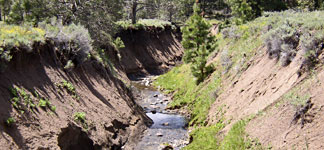|
|||||
� |
Resource Concerns >> Fire and Fuels |
|||||||||
|
Fire and Fuels |
|||||||||
Existing Conditions and Assessment ConclusionsFire is a dominant and natural characteristic of the California landscape. The combination of climate, terrain, and vegetation produces one of the most combustible natural fire environments on earth. Prior to European settlement fires were frequent occurrences in California. Fire scar records derived from tree ring data demonstrate that historic fire-return intervals were variable ranging from as low as 4 years to over 20 years. Following European settlement, specifically in the last 100 years, fire suppression was implemented as a management practice. Over time, commercial logging and the suppression of fire have resulted in conversion of forests with open crown canopies, dominated by large trees, to dense closed crown stands of smaller trees. Fire suppression enabled brush, juniper and some non-native species to invade lowland and coniferous communities. This change in California’s vegetation communities, from open forests, woodlands, and meadows to dense young stands of trees and brush, has significantly increased the amount of fuels and the risk of catastrophic fire. The California Department of Forestry and Fire Protection (CDF) identified areas within the Upper Pit River Watershed, and thus within the Pit RCD, where the abundance of fuels and environmental conditions (topography, vegetation, and climate) are rife for catastrophic fire. Catastrophic fires, generally referred to as stand-replacement fires, are problematic for watersheds as they cause severe erosion due to loss of vegetation, sediment loading in rivers and streams, reduced retention of water in the upper watershed, poor air quality, loss of forage and rangeland, loss of timber, and loss of wildlife habitat. While the forest industry has declined in recent years there is much work to be done to make our forests healthy. Forest improvement projects offer significant employment opportunities for our community while at the same time making our watershed healthier and our communities safer. Both Lassen and Modoc Counties have adopted Community Wildfire Protection Plans (CWPP) that have established priorities for fuel treatments. Management StrategyA. The Pit RCD will support fuel treatment and forest health projects that reduce hazardous fuel loads with the long term goal of the establishment of open crown stands of large trees. Priority projects include the following:
|
Dense young stands were thinned to remove fuel ladders into crowns of older trees, and to reduce competition for nutrients and moisture.This prescribed fire burned the existing brush and will encourage the sprouting of high quality (higher nutritional value) forage for deer and elk. |
|||||||||
